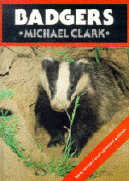New Scientist - Badgers Biting Back

18 April 1998
By Stephanie Pain
A new weapon that could help win the war against
the crime of badger baiting is being tested by police in Britain.
By marking badgers with "Smart Water", an invisible
solution with a unique chemical fingerprint, police can link
suspects and their dogs to the crime. "This means we can
identify anyone who has come into contact with a marked
badger," says Steve Anderson, an inspector in the West
Midlands Police.
The invisible marker, developed by Smartwater
Europe of Telford, Shropshire, has already been successful in
deterring other crimes. Shops known to be protected by Smart Water
sprays triggered by intruders have reported a huge drop in
attempted burglaries. The marker is also an effective way of
stopping the theft of easily carried laptop computers or works of
art, which are almost impossible to sell if they are marked. Now
badgers will be similarly safeguarded. "We can identify which
setts are vulnerable to diggers and provide them with the same
sort of protection," says Anderson.
Badger baiting, in which a badger is pitted
against fighting dogs, has been illegal throughout Britain since
1981. Since then the number of cases has fallen, but hardened
groups of baiters still operate in some areas, often travelling a
long way into the countryside from urban centres such as
Merseyside. Nearby setts are practically "dug out", says
Anderson. "Accessible setts are running out of badgers, so
the diggers have to travel farther afield."
Police have always found it difficult to convict
baiters, who are seldom caught with a badger. By the time officers
reach a disturbed sett or baiting venue, the gang and their dogs
are usually long gone.
So Anderson asked Smartwater if its researchers
could develop a marker that would identify badgers and anyone who
handled them. They came up with a polymer emulsion that glows
under ultraviolet light and includes tiny amounts of chemical
tracers. Each batch has a different "recipe" that can be
used to identify a single sett.
The Forensic Science Service, which now makes the
marker solutions under licence, can analyse marked cloth or hair
and identify which batch--and thus which sett--the marker came
from. The badgers are not harmed by the emulsion.
A suspect marked with a solution--particularly if
it came from a sett some way off--would find it hard to explain
away. "If it's apparent that the badger came from some
distance and there are signs of digging there, you can make the
link between the digging and the offence," says Anderson.
Badgers are not the first animals to benefit from
such protection. Pheasants and pre-Christmas turkeys thought to be
at risk from rustlers, exotic birds--even valuable bonsai
trees--have all been marked in an attempt to foil thieves.
"We have created a deterrent in the minds of
criminals. They are aware of the risks of Smart Water," says
Phil Cleary, managing director of the company. "The message
to baiters is: if you touch this badger we can prove it."
For the full text of this article, please click
the following link:
| Michael Clark
book |
 |
This is a superb book about badgers by Michael
Clark. His immense knowledge of badgers really shines through. Click here to buy:
2017 edition or
2010 edition
or
2010 edition
|
| External News |
|
We have provided links to stories from external news
organisations so you can follow the media interest in badgers, and see who
writes on the subject. We do not endorse external authors. |
 |
|
